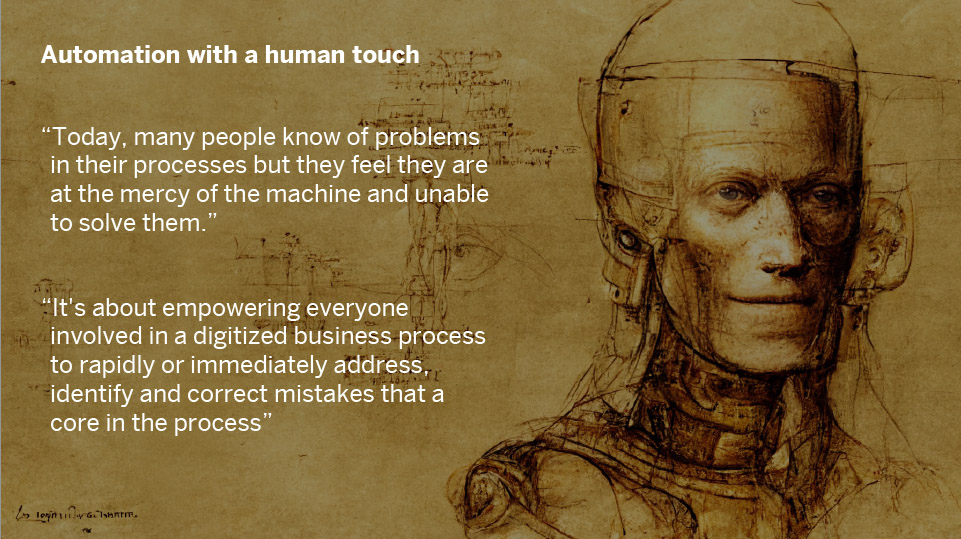Simon Jarke is the Head of Corporate Digital Business Innovation at Freudenberg, a family-owned global technology group headquartered in Germany and founded in 1849.
He recently explained how the organization has taken advantage of the latest technology advances to give business people more agility and control over their processes, without sacrificing standardization and efficiency:
“I think the key to success, especially in times of digital transformation, lies in the philosophy and practices of lean. One core principle of lean is Jidoka, which is about the relationship of man and machine. It means something like machines alone are dumb. Only when humans build in the possibilities of being able to contribute themselves, they can together create value. The machine or process must always guarantee the human the ability to intervene immediately when the assumed conditions no longer exist.
“This idea, sometimes called automation with a human touch must be our vision when it comes to digital machine and processes. The consequences of these ideas are significant: it’s about empowering everyone involved in a digitized business process to rapidly or immediately address, identify and correct mistakes that are core in the process.
“Today, things often look different. Just ask a knowledge worker or a specialist in purchasing, accounting, or sales, to what extent they see themselves today in a position to solve a problem in a process. They often know about inefficiencies, about gaps in the process, but are at the mercy of the machine. They usually do not own the technical limitation of their process, so they cannot intervene immediately when the assumed conditions no longer exist.
“According to Jidoka, what the employee needs is not just a UI to interact with the digitized business process, but rather the way to customize the process quickly and easily.
“But standardized end-to-end processes were the gold standard of the last decade. Do we want to give that up and allow each individual to make adjustments to processes or establish their own? Of course, in the end, we want a consistent and integrated data architecture across the whole enterprise. The good news is you can balance the two: the agility and standardization. And SAP Build Process Automation [part of the SAP Business Technology Platform] is a key component for us to do that.
“How does that look like in practice? Let me give you an example. My colleague, David, is responsible for ordering iPhones for their colleagues, and he has been very unhappy with the process so far.
“Let me give you some background: conceptually, when an employee gets an iPhone, two things happen. First an investment budget is requested and approved to provide the money for the iPhone, and second, then, a procurement process is initiated and run through to purchase the device with this budget.
“Until now the lead time of the process was often several weeks due to many manual steps and hands-offs. This, of course, was a situation that David was not proud of. But then digital process automation came to the rescue. Since all data APIs existed for all the necessary steps, we were able to create so-called actions in SAP Build Process Automation for them.
“This was a step that was done by a pro-code developer, including all the plumbing between S/4HANA, SAP BTP, side-by-side CAP applications and so on, but this action was now available within process automation as an easy-to-use component that David could use to develop a new iPhone ordering process on his own.
“So he built a simple form that only asked three things: who are you, what is your cost center and what iPhone model do you want? And once this form submitted, the proper APIs are called by the actions to create the necessary objects in S/4HANA and run all the approvals necessary there. In S/4, for example, a quite usual purchase requisition is created, no different than the one that you would create using to standard UI. But via a simple iPhone ordering form, it was much easier and faster for the average user. So the orderers are happy, David is happy, the lead time of the process has been massively reduced.
“This example shows what I meant by balancing agility and standardization. Actions in SAP Process Automation are not only a great way to combine the work of pro-code and no-code developers, they are also the extension point, in a sense of Jidoka, to customize the process quickly and easy.
“And this, by building on existing standardization, as in our example, by automatically creating standard Objects in SAP back-end solutions like S/4HANA. The ease at which scenarios like these can be implemented is what made us choose SAP Process Automation. We think that SAP has a unique selling point in this respect, compared to other typical competitors, where the same would be more difficult to achieve.
“Of course, SAP still has a way to go, but we have great confidence and SAP that we share the same vision of more empowerment, more agility, more modularity and more lean thinking in digital process automation.”
